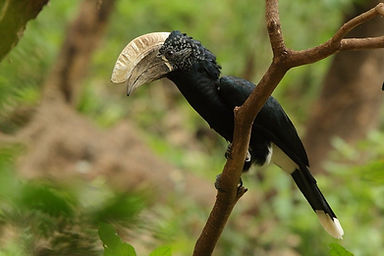Brown-Cheeked Hornbill(Bycanistes cylindricus)
The brown-cheeked hornbill is a large bird, measuring 60-70 cm in length. The male has a large yellow, down-curving beak topped by a casque, a hollow structure attached to the upper mandible. The head, upper parts and underparts are black apart from the reddish-brown cheeks, and the white rump, belly and tail. The female is smaller but otherwise similar to the male apart from having a black beak and casque. Its call is a descending series of coarse croaks "rrah...rrah...rrah...rrah" or "rack kack kak-kak".

Habitat
The brown-cheeked hornbill is native to the Upper Guinean forests region of tropical West Africa, its range including southern Guinea, Sierra Leone, Liberia, Ivory Coast, southwestern Ghana and Togo. These forests are moist deciduous, semi-evergreen mixed forests, typically containing a range of tree species, some of which drop their leaves during the dry season. It is also found in mature second-growth forest

Diet
The brown-cheeked hornbill covers large distances while foraging in the forest. It feeds on fruits and is an excellent disperser of the seeds, which may be deposited as far from their origin as 6.9 km (4.3 mi). Many forest trees have large seeds, and any decrease in the populations of frugivorous birds like the brown-cheeked hornbill is likely to impact adversely on the dispersal of seeds and the regeneration of forest. This hornbill also feeds on insects, which it catches on the wing.
Breeding
Population
According to the IUCN Red List, they are classed as Vulnerable(VU). The population size of this species has not been quantified. The population is suspected to be in rapid decline owing to the destruction and degradation of its habitats and unsustainable hunting pressure.
Threats
The species is threatened by the destruction and fragmentation of forest throughout its range. This species is often the first large hornbill to disappear following selective logging. Although hornbills can travel many kilometres in a single day in search of fruiting trees, the increasing fragmentation of the Upper Guinea forest is likely to have affected populations, particularly as fragmentation is on-going and large fragments are becoming increasingly isolated. Forest is being lost in some protected areas, for example most forest has now been lost from Déré Foret Classée in Guinea. Deforestation in the region is driven by logging for timber, agricultural expansion and development, with some of the highest pressures on forest habitats occurring in Liberia, where there are plans to convert large areas of primary forest to oil-palm plantations. Much forest in Opro River FR, Ghana, has been replaced with teak plantations, whilst forest at Amama Shelterbelt FR has been cleared for gardens and plantations. Hunting is a significant threat both within and outside protected areas. Hunting pressure has led to its extirpation from Bia National Park (NP), where there have been no records since 1991, although it persists at a number of other sites, including small numbers at Atewa Range FR and Tano Ofin FR, despite high hunting pressure at these locations.
Conservation
Conservation Actions Underway
It occurs in a number of protected areas, including Maraoué National Park, Taï National Park and Gola Forest.
Conservation Actions Proposed
Carry out surveys across the species's range to obtain a total population estimate. Track population trends through regular surveys. Monitor rates of habitat loss and degradation across the species's range. Carry out research into levels of hunting. Increase the area of suitable habitat that is protected.